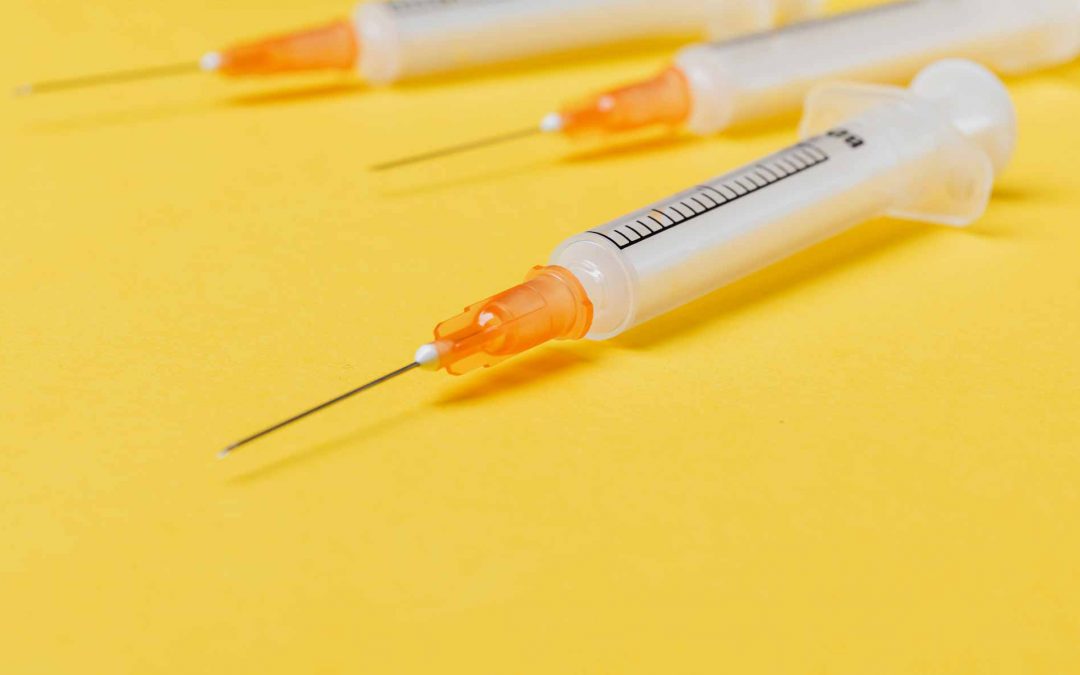We are fortunate to have access to many vaccines designed to protect animals from a variety of diseases, helping us ensure animal well-being and quality. Vaccines can be finicky, however, and require attention to their handling in order to optimize their effect.
Vaccine Handling
Heat, light, cold and dust can all negatively impact our vaccine products. Much of the time, we are vaccinating animals in dusty areas when it’s hot. How can we minimize the effect of the environment on our products?
- Purchase or make a syringe cooler. There are some impressive commercially available coolers or you can simply use a hole saw to make holes to accommodate syringe barrels in a standard plastic or styrofoam cooler to hold syringes between animals. These coolers protect against light, heat and dust.
- If using modified live vaccines, which require mixing of a powder and liquid, only mix the amount of vaccine you expect to use within 60-90 minutes and keep mixed vaccine in the cooler at all times. These vaccines require replication of an altered virus to stimulate the immune response and if the virus dies due to heat, it cannot stimulate an immune response in the animal.
- Always gently shake vaccine bottles prior to drawing up doses to ensure the product is mixed well.
Syringe and Needle Handling
Both disposable and reusable syringes are fine for use with vaccines, but must be cared for correctly to protect their valuable cargo. Because modified live vaccines contain altered virus that can be killed by disinfectants, I typically do not recommend using disinfectants on syringes. Here are some other guidelines for syringe and needle care:
- Carefully remove needles and dispose of in a sharps container or, at a minimum, a plastic jug. Your veterinarian can make recommendations for disposal options for sharps in your area.
- Only use disposable syringes once and throw in the trash after use once the needle is removed.
- For reusable syringes, perform maintenance in a clean, sanitary work area free from blowing dust and contaminants.
- Wash and rinse your hands prior to cleaning syringes. Antibacterial soap and hand sanitizer residue can transfer to syringes and inactivate vaccines.
- Clean all external debris (dust and manure) off syringes with hot tap water and a brush.
- Disassemble the syringes and wash the internal parts with clean, hot tap water. For syringes used for modified live vaccines, do not use soap or disinfectant.
- Boil syringe parts in distilled water for 5 minutes.
- Use a small amount of clean vegetable oil or syringe lubricant for rubber components.
- Reassemble syringes once everything is dry.
- Store the syringes in a clean, dry location.
- Boil reusable vaccine transfer needles (used for rapidly mixing modified-live vaccines) in distilled water for 5 minutes and store in a clean pill bottle or syringe case to keep them clean and prevent dulling.
Vaccine Administration
It also matters how we give the vaccines and how we handle animals during processing. How can we make vaccination of animals as effective and safe as possible?
- Read the label on all products to be used regarding species, diseases protected against, dose, route of administration, and meat or milk withdrawal time. Be sure you’re using the right product for your situation. It can be easy to grab the wrong vaccine when you are purchasing because companies often use the same label color scheme for all their products.
- All injections should be given in the neck, never in the hindquarters.
- Give all injections by the route listed on the label. If given the choice between subcutaneous (under the skin) or intramuscular (in the muscle), choose to give the product under the skin.
- Never give an injection through mud or manure-covered skin.
- A new needle should be used for every animal to prevent transmission of disease. At a minimum, for high-volume processing, needles should be changed every 10 head or when the needle bends or burrs. Bent needles should not be straightened and used as they are likely to break at the site of the bend. If a needle breaks in an animal, that should be recorded and your veterinarian contacted immediately for removal. If the needle cannot be located, that animal must never be slaughtered for consumption.
- Calm, quiet handling of animals is critical to vaccine effectiveness. Stress hormones negatively impact immune responses. We are relying on the body’s immune response to the vaccine to protect from disease. Keeping animals calm can help make sure we are getting every bit of good there is out of our vaccine products.
Vaccinations and other processing procedures are some of the most important things that we do to help ensure animal health and production. Quality work produces quality product and attention to detail is important here. With proper planning and preparation, you can do an excellent job with your syringe and animal handling and still be efficient.

